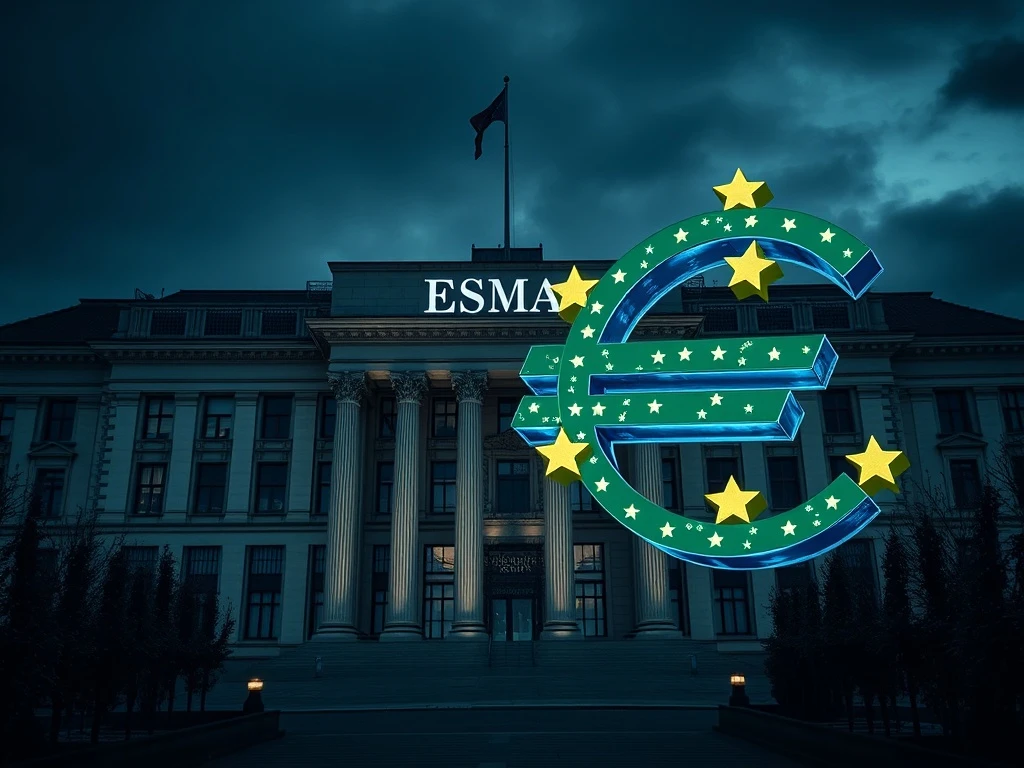Urgent Call: Bank of France Demands Stricter EU Crypto Regulation Under ESMA

The cryptocurrency landscape continues its rapid evolution. Consequently, global financial authorities are intensifying their focus on regulatory frameworks. A significant development recently emerged from the Bank of France. Its governor, François Villeroy de Galhau, issued a compelling call. He advocates for direct oversight of major crypto firms by the European Securities and Markets Authority (ESMA). Furthermore, he seeks to tighten the existing MiCA stablecoin rules. This move aims to protect European financial sovereignty and ensure market stability.
Bank of France Advocates for Centralized EU Crypto Regulation
The Bank of France has strongly urged the European Union to grant its markets regulator, ESMA, direct supervision over major crypto firms. This call stems from concerns that fragmented national oversight could seriously jeopardize the bloc’s financial stability. Speaking at the ACPR-AMF Fintech Forum in Paris, Governor François Villeroy de Galhau articulated this crucial demand. He emphasized that ESMA should receive the mandate to directly oversee crypto-asset issuers under the EU’s landmark Markets in Crypto-Assets (MiCA) framework. This direct oversight ensures consistent rule application and effectively mitigates risks.
Villeroy de Galhau highlighted a critical issue. Relying on individual national regulators risks uneven enforcement across the EU. Crypto companies are scaling at an unprecedented rate within the region. Therefore, a unified approach becomes essential. Direct oversight by the Paris-based ESMA would proactively prevent regulatory arbitrage. It also guarantees that key players adhere to identical standards, regardless of their operational base. The implementation of MiCA represents a decisive step forward. However, its true effectiveness demands a more unified approach. This ensures robust protection for European investors and maintains a level playing field.
MiCA Stablecoin Rules Under Scrutiny
Beyond general oversight, Villeroy de Galhau also addressed the growing threat posed by dollar-backed stablecoins. He specifically identified MiCA’s current allowance for the multi-issuance of stablecoins as a significant regulatory weakness. Under the present framework, companies can issue the same token both inside and outside the EU. They often maintain only partial reserves for these tokens. This practice introduces considerable risk.
The Bank of France governor expressed deep concern. Stablecoins, if unchecked, could weaken the euro. They might also lead to an uncoordinated multiplication of private settlement solutions. Ultimately, this scenario would increase the region’s dependence on non-European and unregulated entities. Such a development directly threatens European financial sovereignty. Other high-ranking officials share these concerns. On September 19, Bank of Italy Deputy Governor Chiara Scotti warned against this model. She stated it could undermine financial stability and requires restriction. While multi-issuance structures may enhance liquidity, they also create substantial legal, operational, and stability risks, especially when issuers operate outside the EU. The European Systemic Risk Board (ESRB) also adopted a recommendation to prohibit this practice, increasing pressure on EU policymakers.
Strengthening ESMA Crypto Oversight for a Unified Market
Villeroy de Galhau insists that completing the European regulatory framework is the solution. He stated, “This framework would benefit from much stricter regulation of the multi-issuance of the same stablecoin from inside and outside the European Union, to reduce arbitrage risks in times of stress.” His comments align with ongoing plans by the European Commission. These plans aim to shift supervision of financial sectors, including crypto, from national regulators to ESMA. Verena Ross, ESMA’s Chair, noted on Monday that such a reform would build a more integrated and globally competitive landscape for the EU. This unified ESMA crypto oversight is critical for market integrity.
Addressing Passporting Issues and Regulatory Gaps
The EU’s MiCA framework includes a feature known as passporting. This allows licensed crypto firms to obtain authorization in one EU member state. Subsequently, they enjoy license validity across all member states. This feature aims to create a single market for crypto providers. It lowers entry barriers and prevents duplicate applications. However, the passporting system, while designed to streamline market access, risks exposing significant gaps. This occurs if national regulators fail to meet their obligations consistently. For instance, in July, ESMA criticized Malta’s licensing process. They found that the country’s financial watchdog only partially met expectations in authorizing a crypto company. This incident raised serious concerns. Weak supervision in one country could trigger a ripple effect across the entire EU.
Furthermore, France’s securities regulator, the Autorité des Marchés Financiers (AMF), voiced concerns about regulatory enforcement gaps tied to the MiCA framework. On September 15, the AMF indicated it might consider refusing the validity of the passporting feature. These issues underscore the urgent need for robust, centralized ESMA crypto oversight. Such a system would prevent individual national weaknesses from compromising the integrity of the broader European market. It ensures that the spirit of EU crypto regulation is upheld consistently.
Safeguarding European Financial Sovereignty in the Digital Age
The Bank of France’s proactive stance underscores a broader imperative. Europe must safeguard its financial sovereignty in the rapidly evolving digital asset space. The proliferation of stablecoins, particularly those pegged to non-European currencies, presents a direct challenge. It risks diminishing the euro’s role and increasing reliance on external financial infrastructures. By advocating for stronger EU crypto regulation and direct ESMA oversight, Villereroy de Galhau seeks to fortify the bloc’s economic independence. He aims to ensure that digital financial innovation serves European interests.
This comprehensive approach to the Bank of France crypto strategy involves several key elements:
- **Centralized Oversight:** Empowering ESMA to directly supervise major crypto firms.
- **Stricter Stablecoin Rules:** Limiting multi-issuance and ensuring full reserves for stablecoins within the EU.
- **Harmonized Enforcement:** Preventing regulatory arbitrage and ensuring consistent application of MiCA.
- **Protecting the Euro:** Mitigating risks that stablecoins pose to monetary sovereignty.
Ultimately, these measures are designed to build a resilient and competitive European digital asset market. They protect investors while maintaining the financial stability and independence of the European Union. The calls for stricter MiCA stablecoin rules and enhanced ESMA crypto oversight are not merely technical adjustments. They represent a fundamental effort to secure Europe’s economic future in a globalized digital economy.








